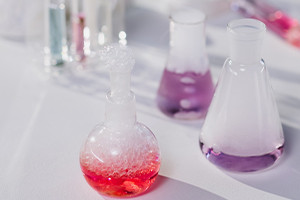Buffer solutions are used during the fermentation process, the calibration of pH metres, dyeing fabrics, leather treatments and during protein and enzyme manufacturing. This advanced chemistry course examines buffer solutions and pH. We begin by studying the self-ionisation of water, the ionic byproduct of neutral water, pH calculations and the pH scale used to indicate the acidity of a solution's range from zero to 14. We then investigate the pH metre, which measures a solution's pH. The course then covers strong acids and strong bases and explains how to calculate their pH and dissociation constant (Kₐ) before moving on to the general dissociation reaction of weak acids.
The course then explains how indicators like methyl violet and thymol blue and acid-base titration procedures are used to determine the equivalence point of neutralisation reactions. We outline the two types of buffer solutions, acidic and basic, and show you how an acid buffer works when adding an acid or a base, shifting the reaction to the left or right. The course also discusses how rainwater serves as a buffer while acid rain does not and demonstrates how to calculate the pH of a buffer solution.
Finally, we study the equilibrium system found in saturated solutions and solubility, which measures how much solute can dissolve in a solvent at a specific temperature. We define the term ‘solubility product’ and break down its general formula and the ionic product of some sparingly soluble salts. The course then explains how to calculate the solubility product of sparingly soluble ionic salt. We show you how to predict when salt will start to precipitate while dissolving in water and describe the common ion effect on the solubility of the ionic compound. Lastly, we study the partition coefficient and explain how to use it to calculate the concentration of compounds. This advanced chemistry course suits students and aspiring chemists who want to understand pH, chemical equilibrium and solubility. Sign up to play with the building blocks of life and understand the hidden processes going on all around you.
What You Will Learn In This Free Course
View All Learning Outcomes View Less All Alison courses are free to enrol, study, and complete. To successfully complete this Certificate course and become an Alison Graduate, you need to achieve 80% or higher in each course assessment.
Once you have completed this Certificate course, you have the option to acquire an official Certificate, which is a great way to share your achievement with the world.
Your Alison certificate is:
- Ideal for sharing with potential employers.
- Great for your CV, professional social media profiles, and job applications.
- An indication of your commitment to continuously learn, upskill, and achieve high results.
- An incentive for you to continue empowering yourself through lifelong learning.
Alison offers 2 types of Certificate for completed Certificate courses:
- Digital Certificate: a downloadable Certificate in PDF format immediately available to you when you complete your purchase.
- Physical Certificate: a physical version of your officially branded and security-marked Certificate
All Certificate are available to purchase through the Alison Shop. For more information on purchasing Alison Certificate, please visit our FAQs. If you decide not to purchase your Alison Certificate, you can still demonstrate your achievement by sharing your Learner Record or Learner Achievement Verification, both of which are accessible from your Account Settings.











 Avg. Hours
Avg. Hours  Contains Video
Contains Video  CPD Accredited
CPD Accredited 
 Total XP:
Total XP: 
 Knowledge & Skills You Will Learn
Knowledge & Skills You Will Learn 







